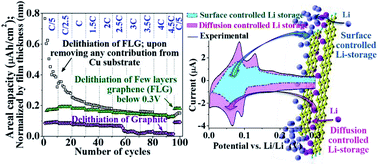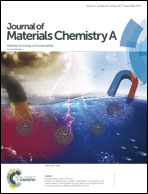Understanding the Li-storage in few layers graphene with respect to bulk graphite: experimental, analytical and computational study†
Abstract
In order to understand, clarify and provide confirmations in the contexts of the prevalent confusions concerning Li-storage in graphenic carbon (viz. the reduced dimensional scale of graphitic carbon), electrochemical lithiation/delithiation has been performed with CVD-grown fairly pristine well-ordered few-layer graphene films (FLG; ∼7 layers; as a model material). Chronopotentiograms and cyclic voltammograms recorded with the FLG present distinct features corresponding to the transformation between different Li-GICs (i.e., ‘staging’) below 0.3 V against Li/Li+, thus confirming that ‘classical’ Li-intercalation does occur even at such reduced dimensional (nano)scale. Nevertheless, even in this lower potential window (our main focus here), Li-storage in FLG involves contributions from both diffusion- and surface-controlled mechanisms. The Li-capacities recorded with FLG just within this lower potential window, and also upon subtracting any possible contribution from the Cu current collector, were still ∼3–4 times greater than those obtained with similarly grown thicker bulk graphite films (TBG: ∼450 nm; Li-capacity recorded: ∼380 mA h g−1). Contrary to the usual belief, the excess Li-capacity of FLG cannot be explained by the presence of extrinsic/intrinsic defects, which are nearly negligible in the FLG films under consideration. Simulation of Li-storage in graphene via DFT indicated that the excess capacity (after formation of the LiC6 configuration) is associated with additional stable Li-storage on the outer graphene surfaces in the forms of more than one Li-layer (but different from Li-plating) and segregation close to the ‘stepped’ (exposed) edges of the inner graphene layers (but not exactly at the edge sites). Overall, such predicted Li-storage mechanisms are in agreement with the experimentally observed contributions from both ‘classical’ Li-intercalation and surface-controlled processes (even at potentials below 0.3 V), which primarily account for the excess Li-capacities recorded with graphenic carbon.



 Please wait while we load your content...
Please wait while we load your content...